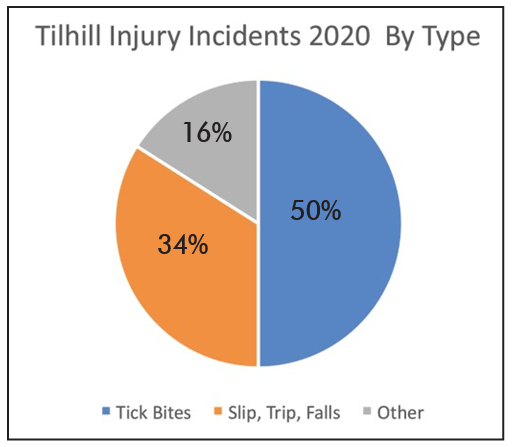2020 was a record-breaking year for Tilhill with a whole year completed without a RIDDOR Reportable injury.
- That isn’t to say there weren’t other injuries sustained through our work. However serious the potential or actual injury, we always record and investigate, even when no actual injury occurred.
Infections arising from tick bites present a serious health risk, and one that is hard to avoid working in forestry. As such we record tick bites as minor injuries. You can see above that tick bites account for half of the injuries recorded in 2020. As it is not possible to avoid the risk it is important that ticks are found as soon as possible and removed safely. This reduces the risk of infection occurring. Our statistics show that the leg was the most common place for tick bites to occur so consider wearing trousers that are treated to repel ticks. Tilhill make these available to our own staff upon request.
The second most common cause of injury was from slips, trips and falls while making our way around site. In forestry this is a perennial issue. Incidents included stepping into ditches, badger setts, slipping on rocks and tripping on vegetation.
Awareness and good footwear can help reduce slips, trips and falls. Some staff have benefitted from using walking poles to help steady themselves.
These figures mask the incidents that have the most serious potential. Being struck by a falling object was the second highest source of near misses, but only accounted for one injury. The main risks come from high stacks, pedestrians walking into machinery risk zones and falling objects during chainsaw felling. Being struck during chainsaw felling remains a high risk. With the spread of Ash Dieback Disease and the effect it has on the tree, this must be held in sharp focus when planning and undertaking this work. We will continue our work in 2021 to improve our management of chainsaw work and support FISA in its work around chainsaw operator competence.
The top cause of near misses was haulage having difficulty accessing forest sites in some form. We must ensure that access routes are suitable, maintained and clearly communicated to hauliers and drivers. The third highest cause of near misses involves machinery. There isn’t a strong trend in any type of machine or cause, but they do produce some of the most striking images.
We will be reflecting on these incidents and the investigations to help us further improve. We cannot do this alone. We need everyone to play their part and report near misses whether they relate to health, safety or the environment. We will investigate openly and find the root cause of incidents so we can improve. Almost all root causes come back to organisational factors.
Environmental Incidents
We report and review all environmental incidents whether they are direct impacts, near misses or concerns raised about our worksites.
Over the past two years we have seen a slight decrease in incidents reported such as oil spills and diffuse pollution events but an increase in concerns raised by third parties in relation to forestry and harvesting activities. These concerns range from timber wagon haulage noise and nuisance to concerns about harvesting during bird nesting season.
Every time we instruct forestry or harvesting we complete an environmental risk assessment and consider seasonal aspects and the impacts of our activities, ensuring we are working within the law and causing minimal disturbance on our worksites.
Much of forestry management and harvesting work results in gains in biodiversity, whether that is through restructuring of a forest or careful planning of drainage and maintaining buffer areas to protect riparian zones and meet UK Forestry Standard guidelines.








